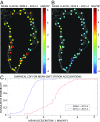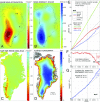Accelerating changes in ice mass within Greenland, and the ice sheet's sensitivity to atmospheric forcing
- PMID: 30670639
- PMCID: PMC6369742
- DOI: 10.1073/pnas.1806562116
Accelerating changes in ice mass within Greenland, and the ice sheet's sensitivity to atmospheric forcing
Abstract
From early 2003 to mid-2013, the total mass of ice in Greenland declined at a progressively increasing rate. In mid-2013, an abrupt reversal occurred, and very little net ice loss occurred in the next 12-18 months. Gravity Recovery and Climate Experiment (GRACE) and global positioning system (GPS) observations reveal that the spatial patterns of the sustained acceleration and the abrupt deceleration in mass loss are similar. The strongest accelerations tracked the phase of the North Atlantic Oscillation (NAO). The negative phase of the NAO enhances summertime warming and insolation while reducing snowfall, especially in west Greenland, driving surface mass balance (SMB) more negative, as illustrated using the regional climate model MAR. The spatial pattern of accelerating mass changes reflects the geography of NAO-driven shifts in atmospheric forcing and the ice sheet's sensitivity to that forcing. We infer that southwest Greenland will become a major future contributor to sea level rise.
Keywords: GNET; GRACE; NAO; SMB; mass acceleration.
Copyright © 2019 the Author(s). Published by PNAS.
Conflict of interest statement
The authors declare no conflict of interest.
Figures





References
-
- Velicogna I, Wahr J. Acceleration of Greenland ice mass loss in spring 2004. Nature. 2006;443:329–331. - PubMed
-
- Khan SA, Wahr J, Bevis M, Velicogna I, Kendrick E. Spread of ice mass loss into northwest Greenland observed by GRACE and GPS. Geophys Res Lett. 2010;37:L06501.
-
- Wouters B, et al. GRACE, time-varying gravity, Earth system dynamics and climate change. Rep Prog Phys. 2014;77:116801. - PubMed
-
- Van den Broeke MR, et al. On the recent contribution of the Greenland ice sheet to sea level change. Cryosphere. 2016;10:1933–1946.
Publication types
LinkOut - more resources
Full Text Sources
Other Literature Sources

